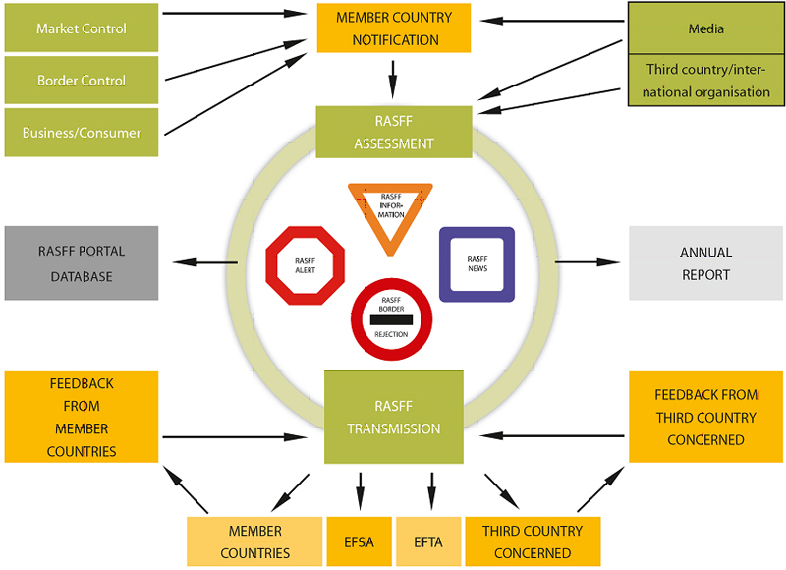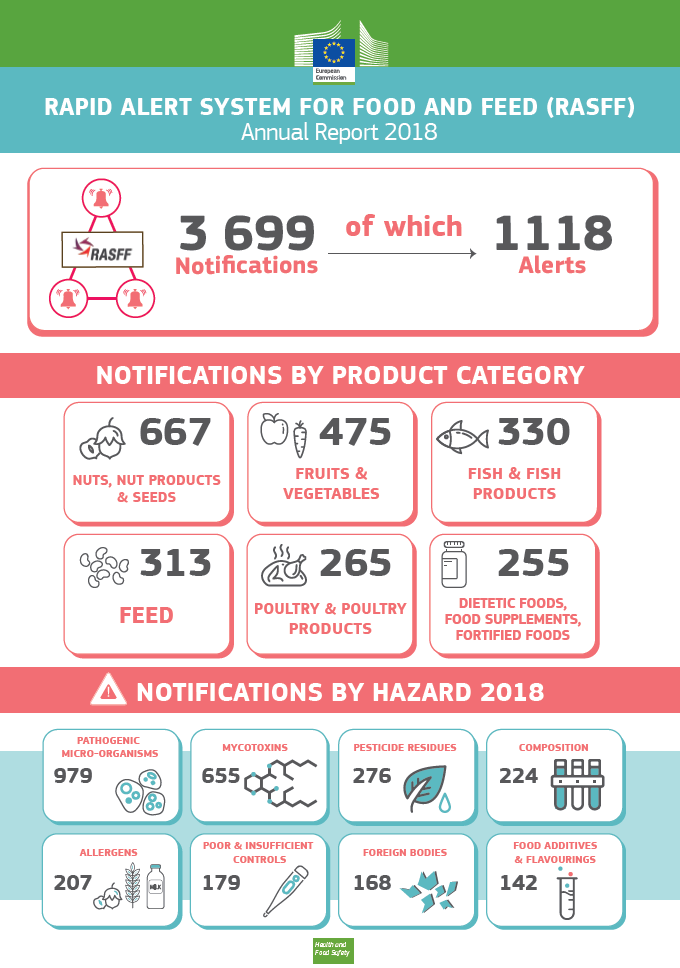Published: 13/03/20 11:30 Categories: Microbiology
Hundreds of notifications of risks related to human consumption or animal feeding are published every year. These notifications are used to take the necessary measures to ensure food safety within the European Union. But do we know the process that results in the withdrawal of a product that we regularly consume at home?
EFSA and RASSF: Partners in Food Safety
During the 1990s, the EU faced a number of food crises such as outbreaks of BSE and salmonellosis, as well as dioxin-contaminated food, which made it clear that measures to review food safety were needed.
To this end, the European Food Safety Authority (EFSA) was created to provide scientific advice and technical support in areas with an impact on food safety. On the other hand, the EFSA is also responsible for the communication of risks associated with the food chain, however, it is not the one in charge of making such notifications since the RASSF, the rapid alert system for food and feed, serves this purpose.
The RASSF was created more than 40 years ago with the objective of reporting risks in food, feed and products that have been identified by the notifying country, and sharing this information efficiently among its members: Food safety authorities, the Commission or the EFSA, to mention a few. The RASFF provides a 24-hour service to ensure that urgent notifications are sent, received and replied to.
How do RASFF notifications work?

European Comission. (Without date). How are notifications made. How does RASSF work.
The RASFF work has prevented food risks from harming consumers, as information can lead to product recalls.
Four types of RASFF notifications can be distinguished:
- Alerts: when the health risk is serious and, is present in the market, so members are required to take prompt action and measures.
- Information: when a risk has been identified, but rapid action should not be taken because the product has not arrived/is not present on the market or the nature of the risk is not serious.
- Border rejections: when a health risk has been found by testing and rejecting products at borders outside the EU/EEA.
- News: any related information that has not been communicated in any previous notification.
The last annual report issued by the RASFF covers the year 2018, during which 3,699 new notifications were issued, of which 1,118 were alerts. The vast majority came from official controls of the internal market (EU and EEA), followed by border controls. Finally, a small number of notifications were initiated by official controls in non-member states.
And what happens when more than one notification is related to each other? This is referred to as an incident, of which there are several types identified: Accidental or environmental contamination, labelling, faulty processing or storage, food-borne outbreaks, contamination by a foreign body or physical hazard, fraud investigation, hazardous or unauthorized composition, and intentional contamination/handling.
What were the most recurrent microbiological hazards?
In this regard, during 2018 there were 979 notifications for danger of pathogenic microorganisms, representing an increase of 19% over the previous year, and with L. monocytogenes and Salmonella being the main causes of incidents. Norovirus, STEC, Campylobacter, Bacillus cereus and Staphylococcus are other reported pathogens.
Another important category of danger are the mycotoxins produced by fungi of Aspergillus genus. They are extremely important because, although the levels usually found in food do not produce an acute adverse effect, chronic exposure may present a high health risk to consumers, especially aflatoxins, with Aflatoxin B1 (A. flavus and A. parasiticus) being the most toxic classified as carcinogenic and genotoxic.
Foods with the highest number of these notifications are nuts, dry fruit and seeds, evidently due to their link to the presence of aflatoxins. Secondly, there are fruits and vegetables, especially frozen ones, which are linked to contamination by Listeria monocytogenes, followed by products related to fish, feedingstuffs, poultry and dietetic food, supplemented and fortified.
Regarding animal health, during 2018, 313 notifications were issued in relation to feed, which represents 9% of the total RASFF notifications.
That said, while pathogenic microorganisms, mainly Salmonella, and mycotoxins (aflatoxins) are the main dangers, there is a new category: the microbial contaminants arising from the ashes of non-pathogenic organisms. An example are the count limits for Enterobacteriaceae that cannot exceed 300 CFU/g in 5 samples from different lots of feed of animal origin.
Member states and international organizations are establishing protective, warning and response barriers to potential threats from these microbial risks. Having said that, as new data become available it will be necessary to adapt and improve control measures in order to face new threats that may arise.
You can consult the RASFF infographic with all the information below:

European Comission. (2019). Rapid Alert System For Food and Feed (RASSF). Annual Report 2018.

 Food fraud: How do we detect it?
Food fraud: How do we detect it?
 Visit Us at MEDICA 2025 – Discover Our Precise Detection Solutions
Visit Us at MEDICA 2025 – Discover Our Precise Detection Solutions
 PCR: The Technique Revolutionizing Rapid Detection in the Food Industry
PCR: The Technique Revolutionizing Rapid Detection in the Food Industry
 How Culture Media Ensure the Safety, Efficacy, and Quality of Medicines
How Culture Media Ensure the Safety, Efficacy, and Quality of Medicines
 Meeting us at MEDLAB MIDDLE EAST 2025
Meeting us at MEDLAB MIDDLE EAST 2025